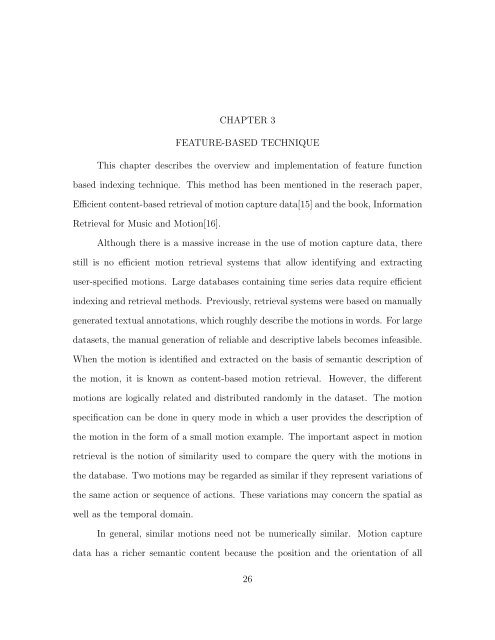A COMPARISON AND EVALUATION OF MOTION INDEXING ...
A COMPARISON AND EVALUATION OF MOTION INDEXING ...
A COMPARISON AND EVALUATION OF MOTION INDEXING ...
You also want an ePaper? Increase the reach of your titles
YUMPU automatically turns print PDFs into web optimized ePapers that Google loves.
CHAPTER 3<br />
FEATURE-BASED TECHNIQUE<br />
This chapter describes the overview and implementation of feature function<br />
based indexing technique. This method has been mentioned in the reserach paper,<br />
Efficient content-based retrieval of motion capture data[15] and the book, Information<br />
Retrieval for Music and Motion[16].<br />
Although there is a massive increase in the use of motion capture data, there<br />
still is no efficient motion retrieval systems that allow identifying and extracting<br />
user-specified motions. Large databases containing time series data require efficient<br />
indexing and retrieval methods. Previously, retrieval systems were based on manually<br />
generated textual annotations, which roughly describe the motions in words. For large<br />
datasets, the manual generation of reliable and descriptive labels becomes infeasible.<br />
When the motion is identified and extracted on the basis of semantic description of<br />
the motion, it is known as content-based motion retrieval. However, the different<br />
motions are logically related and distributed randomly in the dataset. The motion<br />
specification can be done in query mode in which a user provides the description of<br />
the motion in the form of a small motion example. The important aspect in motion<br />
retrieval is the notion of similarity used to compare the query with the motions in<br />
the database. Two motions may be regarded as similar if they represent variations of<br />
the same action or sequence of actions. These variations may concern the spatial as<br />
well as the temporal domain.<br />
In general, similar motions need not be numerically similar. Motion capture<br />
data has a richer semantic content because the position and the orientation of all<br />
26
















